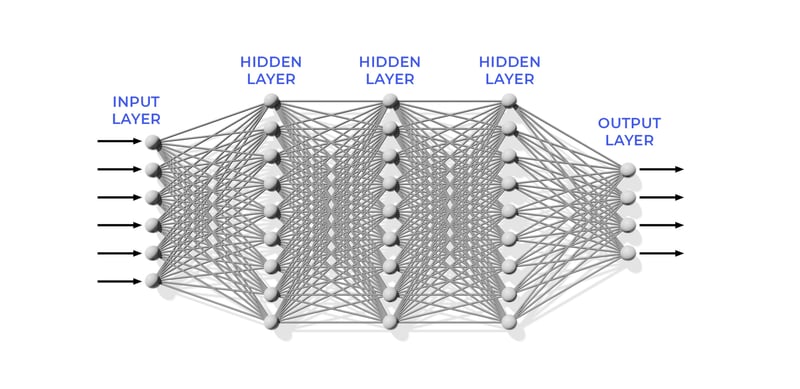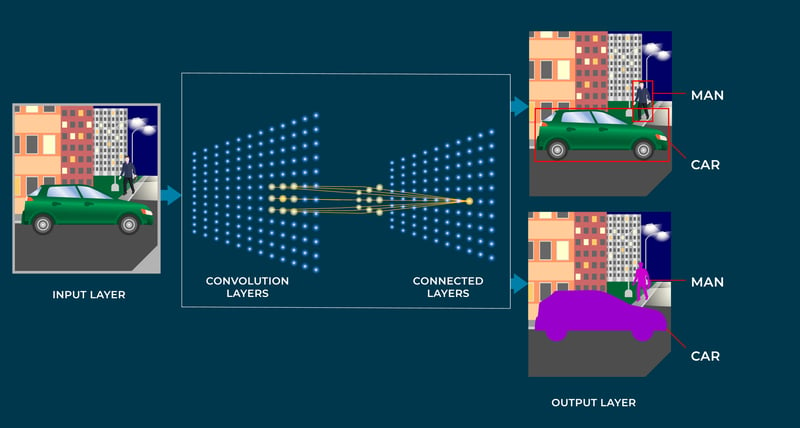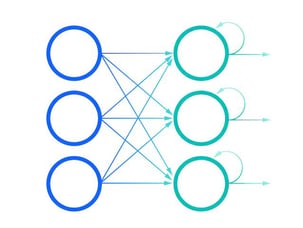
What is Deep Learning?
Deep Learning (DL) is a subfield of machine learning that works with algorithms inspired by the structure and functions of the human brain called "neural networks".
This tool has helped create search engines from images, personalized marketing based on people's preferences, fraud prevention, and detection of cybersecurity incidents through the behavior of individuals. It is a technology that powers artificial intelligence applications through a deep understanding of complex information and environments.
This article will teach you the operation, process, and applications of Deep Learning.
Table of Contents
- What is Deep Learning?
- How does Deep Learning work?
- Types of neural networks
- Difference between Artificial Intelligence, Deep Learning, and Machine Learning
- 3 methods to improve Deep Learning models
- 3 most common applications of Deep Learning
- Limits and challenges of Deep Learning
- How to start using Deep Learning in your business?
How does Deep Learning work?
Deep Learning is an essential element of data science, including statistics and predictive modeling. It is highly beneficial for data scientists tasked with collecting, analyzing, and interpreting information to solve complex problems.
Deep Learning makes the processes of large companies or projects faster and easier. It can automatically provide analysis, detect relationships, project results, and make predictions on a certain amount of data.
The secret of Deep Learning lies in its neural network algorithms, which are inspired by the structure and functions of the human brain. Just as a biological neuron receives and transmits electrical impulses, an artificial neuron receives information to transform it and send it to other neurons.
The grouped neurons are called "neural networks" which can learn and identify information. These networks receive external stimuli from a layer called the input layer where the neuron creates an internal calculation to generate a value for the output layer.
Each input stimulus is assigned a value that can be modified to define whether it will positively or negatively affect the result. These values are added together to identify the parameters of our model so that the neural network can generate an output value depending on its training and the objective for which it is being used.
In other words, neural networks process millions of pieces of data so that computers observe, learn and react to difficult situations more accurately and faster than people.
Types of neural networks
Most Deep Learning models today use one of these three types of neural networks as their basis: Artificial Neural Network (ANN), Convolutional Neural Network (CNN) or Recurrent Neural Network (RNN).
1. Artificial Neural Network
An artificial neural network or forward propagation network consists of artificial neurons together and grouped in different levels known as layers.
A neural network with a single layer can only make approximate predictions, so the additional hidden layers help optimize the accuracy of the results produced by the system. As a network is trained with information, it modifies its neurons until it can draw the correct conclusions to reach a pre-set goal.
These are the 3 layers applied in structured artificial neural networks:
- Input Layer
It is composed of the neurons that assimilate the input data, for example, an image or data table. It is composed of real data that feeds the neural network.
- Hidden Layer
There can be one or more hidden layers in a neural network. The more information it has, the more complex the analysis it performs. For example, this layer can detect the content of an image such as its color, objects, letters, and more. In addition, it can create hundreds of combinations to process the information and perform the necessary calculations.
- Output Layer
This is the layer that makes the decision, provides conclusions or performs the required activity depending on the data provided by the hidden layer.

2. Convolutional Neural Network
Convolutional Neural Networks (CNN) are used in image recognition and Computer Vision applications. They can capture the spatial characteristics of an image. That is, they analyze the arrangement of pixels in an image and their relationship to each other. They are used to extract the most important features of an image.
Convolutional neural networks share parameters that are applied to different sections of the input data to create a feature map. This map allows for classifying various recurring features in an image and subsequently identifies them automatically.

3. Recurrent Neural Network
Recurrent Neural Networks (RNN) are used in natural language and speech recognition applications by processing sequential data. This mechanism endows this network with memory. They can process different types of data at various moments in time.

Recurrent neural networks can process the input and output of the sequence regardless of its size, considering the correlation between the different elements of this sequence.
Differences between Artificial Intelligence, Machine Learning, and Deep Learning
The main differences between Artificial Intelligence, Machine Learning, and Deep Learning lie in their scope and focus. While Artificial Intelligence encompasses many fields within computer science, such as cloud computing and the internet of things, Machine Learning and Deep Learning are more concerned with models that allow machines to learn, as their names imply.
Here’s a quick breakdown of the three:
- Artificial Intelligence: Computer Science field that studies how to create computer programs with the ability to reason like humans, solving problems quicker and more effectively than people. AI allows technological systems to perceive their environment, relate to it, solve problems and act with a specific purpose.
- Machine Learning: An AI subset dedicated to creating algorithms that allow systems to learn without the need to be programmed. The workflow of this tool starts with the manual extraction of relevant features to create a model that can categorize or process such information.
If you want to know more about how this technology works, read here our article: What is Machine Learning and how it works?
- Deep Learning: It is a subset of Machine learning focused on the creation of artificial neural networks, which are systems that mimic the human brain by adapting and learning from large amounts of data. Unlike Machine Learning, this tool extracts features directly from databases without manual labels.
3 methods to improve Deep Learning models
There are several methods to achieve greater robustness and efficiency in Deep Learning models. Here are the most important ones:
1. Learning rate decay
It is an adjustable parameter that allows controlling the training process of a model, this method defines the system and establishes the conditions for its correct operation before it learns and identifies information.
Its objective is to estimate and control the change experienced by the model in response to the estimated error each time it is modified.
2. Transfer learning
This method consists of refining a model that has already been trained on data.
Once this action is done, you can make new activities with more specific categorization capabilities than before. Its main advantage is that it requires less data than other models, which reduces computation time.
3. Dropout
This model attempts to solve the problem of overfitting in networks with large numbers of parameters. In addition, it randomly eliminates neural network connections during training.
This method has been shown to improve the performance of neural networks in supervised learning tasks such as speech recognition and document classification.
3 most common applications of Deep Learning
Deep Learning is already present in several processes in which we participate daily.
The most successful products and services using DL are autonomous vehicles and language translation. But currently, these are the three most common applications of Deep Learning:
1. Customer Service
Based on Deep Learning models, several companies and applications have implemented chatbots to improve customer experience and service. Their main objective is to increase customer satisfaction, solving problems without so much waiting time.
Companies are looking for their chatbots to be useful and easy to use in customer service situations.
2. Computer Vision
Deep Learning has revolutionized the detection, identification and segmentation of objects in images and videos, also known as Computer Vision, thanks to the speed of this technology. Compared to other mechanisms, Deep Learning does not have to specify all the characteristics of objects, figures, letters, or colors in an image or video to automatically identify, classify, and detect them. This technology can analyze more than one object in a picture at high speed and efficiency.
An example of this technological breakthrough is vehicleDRX, an ally in vehicle detection and tracking for law enforcement. It uses video surveillance networks to identify vehicles based on their color, make, last seen, or last known location.
3. Large-scale predictive analytics
This technology can more accurately monitor and understand consumer behavior, automatically identifying purchase intentions and providing recommendations based on the past behavior of other users with a similar purchase history.
Companies such as Amazon or Alibaba use this type of technology to meet the high demand of their users.
Limitations and challenges of Deep Learning
Deep Learning brings many benefits to various high-growth companies and industries. However, the accelerated advancement of this technology can have consequences if not addressed in time.
These are the main limitations and challenges of Deep Learning.
- It requires powerful hardware to be able to process millions of data.
- These technologies will be able to do things independently, but the actions and decisions they make must be monitored frequently by humans to ensure proper functioning.
- It learns through observation. So, if the data provided is not representative, it will not understand comprehensively
- It is expensive due to the processing units required and its consumption of large amounts of energy.
How to start using Deep Learning in your business?
Deep Learning combines the flexibility of human visual inspection with the consistency and speed of a computer. This tool pushes the boundaries of what a machine as we know it today can do.
To evaluate whether Deep Learning is a technology worth implementing in your organization or project, you can go through the following process:
- Understand the problem and analyze whether Deep Learning is the right choice. Not all problems require or can support this technology. Consult with subject matter experts about their opinion.
- Identify the relevant data. Once you know why you will use Deep Learning, make sure you have the minimum information to start implementing this technology. This step can take considerable time, so plan accordingly.
- Identify the best Deep Learning algorithms for your business. It is important to understand the different use cases or applications of the various Deep Learning technologies before implementing them. Make sure you work with a team that can create DL projects according to your needs.
- Start by training the algorithm with a large amount of labeled data. It is important to recognize the different stages of training your model and feed it with the information it needs to begin training.
- Test the performance of your Deep Learning model. An essential rule of Deep Learning is to test, test, test. This is the only way to know its effectiveness.
- Optimize your Deep Learning model until you achieve the expected goal. One of the great benefits of this technology is its improvement over time. As you adjust the parameters necessary for its operation, its performance will increase.
HOW TO START USING DEEP LEARNING IN YOUR BUSINESS?

Deep Learning has given a great boost to the field of artificial intelligence thanks to the possibility of being an ally for organizations with large amounts of data or complex problems without being supervised by several people. In addition, Deep Learning-trained computers can take over abstractions or ill-posed problems and help companies deal with sensitive customer information.
And learn all about our autonomous AI, the technology that is the foundation of our technology, in our autonomous artificial intelligence guide.